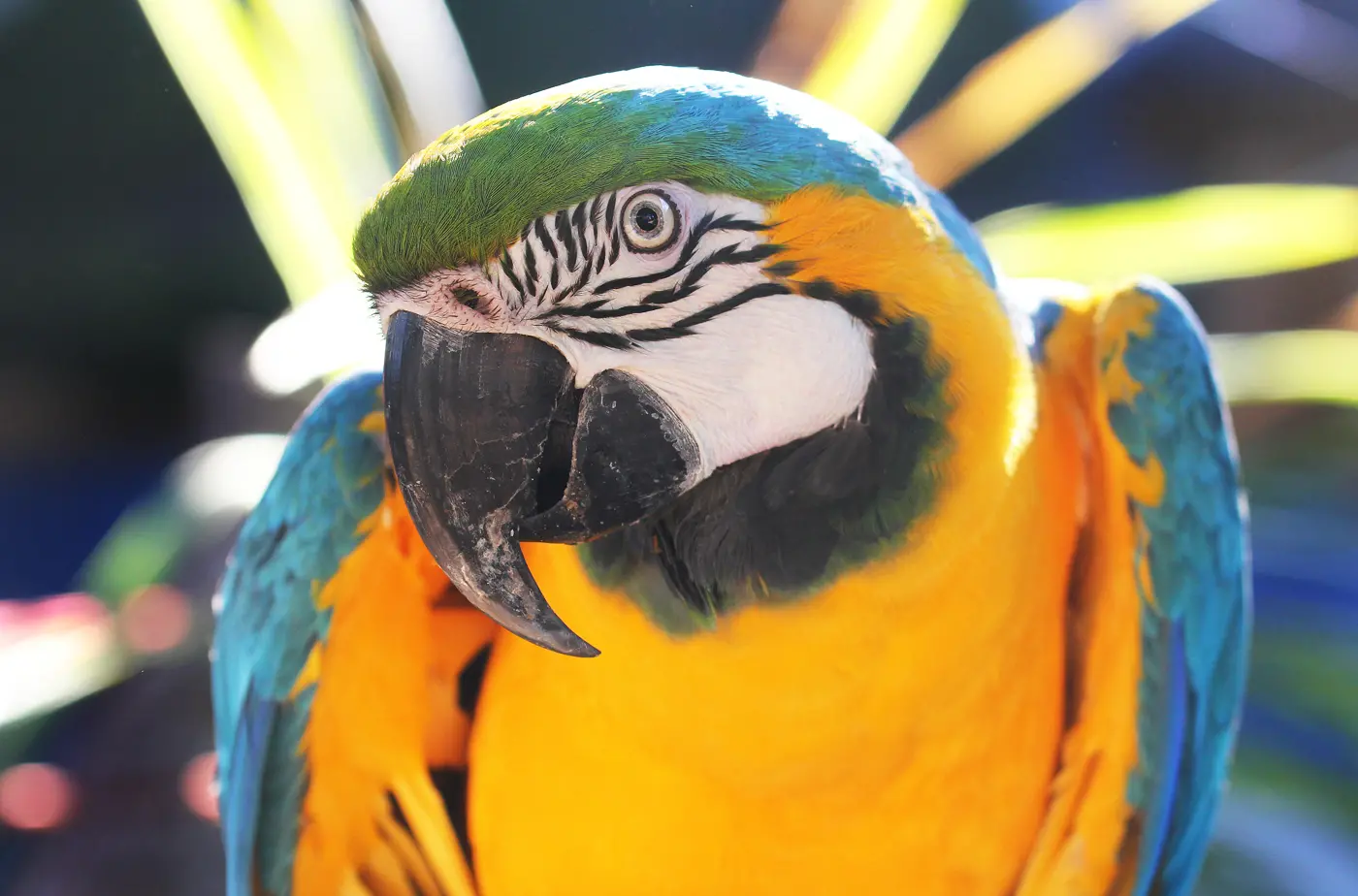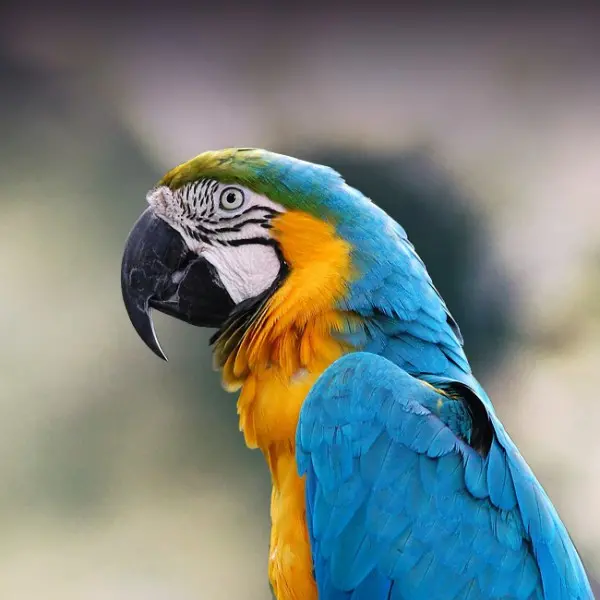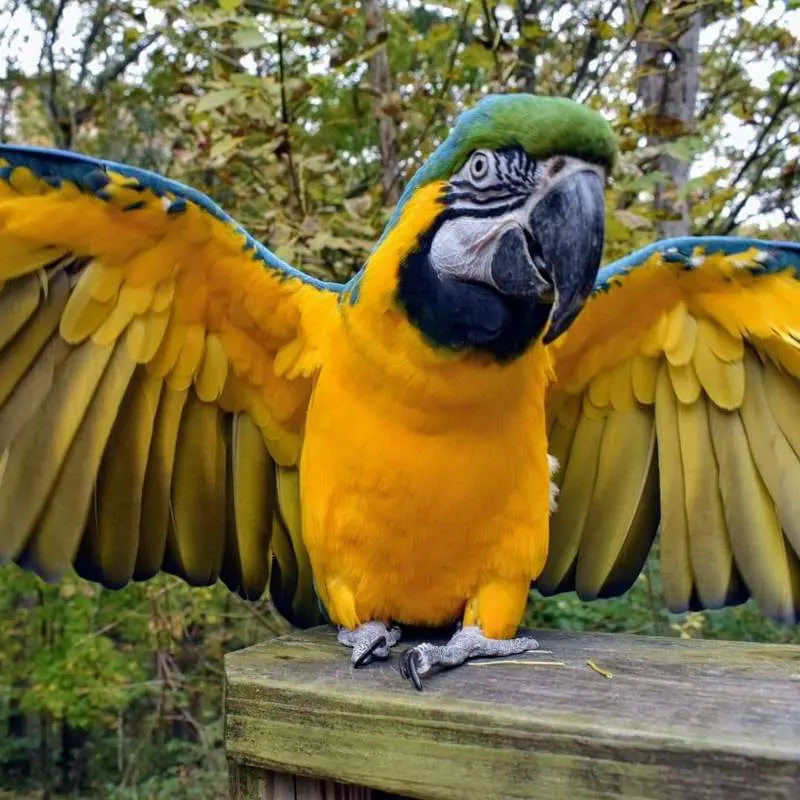Blue and Gold Macaw: A Comprehensive Guide to Characteristics, Habitat, Diet, and Conservation
The blue and gold macaw (Ara ararauna), known for its stunning beauty and captivating personality, is a large parrot species native to Central and South America. This magnificent bird is not just a visual marvel with its brilliant hues of blue and yellow; it also boasts exceptional intelligence and social behavior that make it a favorite among avian enthusiasts and pet owners alike.
As we delve deeper into the life of the blue and gold macaw, we uncover the multifaceted aspects of its existence, from its striking physical characteristics to its essential role in ecosystems and its fame as a companion animal. This article serves as a comprehensive guide to understanding this remarkable species, exploring its anatomy, behavior, habitat, diet, and conservation status, all while celebrating the splendor of this avian wonder.
Characteristics of Blue and Gold Macaw
The blue and gold macaw is a true emblem of avian beauty, standing out with its bold coloration and engaging demeanor. Comparatively, this species is larger and more social than many other parrot species, making it an enchanting presence in both the wild and captivity. Its striking appearance can be likened to a flamboyant painter’s palette, splashed with vivid blues, radiant yellows, and hints of green that serve both aesthetic and functional purposes. These macaws are inherently social creatures that thrive on interaction and engagement, reflecting their vibrant personality through laughter and chatter.

Key characteristics of the blue and gold macaw include their impressive intelligence and adaptability, which can be compared to that of a six-year-old child in terms of problem-solving capabilities. This intelligence manifests in their ability to mimic sounds and speech, showcasing their ability to communicate effectively within their social structures. In addition, their robust physical features, including powerful beaks and zygodactyl feet designed for climbing and foraging, make them well-suited for their natural habitats.
The combination of physical beauty and a charming personality, along with their intelligence and social nature, makes blue and gold macaws one of the most desirable companion birds for pet owners. However, these traits also require their caregivers to provide ample stimulation and companionship to prevent behavioral issues. Ultimately, the blue and gold macaw represents much more than just a colorful bird; it embodies the intertwining of beauty, intelligence, and the necessity of social bonds in the avian world.
Physical Appearance
The physical appearance of the blue and gold macaw is undeniably captivating. Measuring between 76 to 86 cm (30 to 34 inches) in length when fully grown, these birds possess impressive proportions that contribute to their majestic aura. Their wingspan ranges from 102 to 112.5 cm (about 41 to 45 inches), allowing them to glide gracefully through the lush canopy of their tropical homes.
Distinctive Features:
- Coloration: The upper body is adorned with bright aqua-blue feathers that create a striking contrast against the rich, sunny yellow of their underbelly. This vibrant coloration serves a dual purpose: it attracts potential mates and provides a degree of camouflage amidst the vibrant foliage of their natural habitat. The head features a vivid green crown that works harmoniously with their overall color scheme.
- Facial Features: One of the most notable characteristics of the blue and gold macaw is its nearly featherless facial skin, which is framed by a pattern of sparse black feathers, creating a unique striped effect around the eyes. The pale yellow irises add to their expressive facial features, evoking a sense of curiosity.
- Beak and Feet: Their robust black beak is designed to crack open the toughest of seeds and nuts, showcasing their adaptation to a diet that requires strength and precision. The macaw’s feet are zygodactyl, meaning they have two toes facing forward and two facing backward, allowing them to grip branches firmly while climbing.
- Tail: Perhaps one of their most enchanting features is their long, pointed tail, which can stretch an additional one to two feet. This tail not only aids in their skilled flight but also serves as a balance tool when they perch and maneuver among treetops.
- Weight: Blue and gold macaws typically weigh between 900 to 1,200 grams (about 2 to 2.7 pounds), giving them a substantial presence among other parrot species.
- Lifespan: In captivity, these remarkable birds can live for 50 to 60 years, with some reaching up to 80 years. This extended lifespan requires owners to commit to long-term care and companionship.
In summary, the physical features of blue and gold macaws not only enhance their beauty but also reflect their ecological adaptations, allowing them to thrive amidst the exotic foliage of their native habitats.
Coloration and Plumage
The coloration and plumage of the blue and gold macaw present a spectacular visual feast, showcasing nature’s artistry in avian design. Their feathers can be described as a living canvas, vibrant and full of life, echoing the exotic environments in which they reside.
Key Aspects of Their Coloration:
- Brilliant Blue and Yellow: The upper parts of the body are cloaked in bright aqua-blue feathers that shimmer in the sunlight, while the underparts are a brilliant, warm yellow that brings a golden glow to their appearance. This striking contrast creates a visual spectacle that is both captivating and functional, aiding in communication and mate selection.
- Green Crown: The presence of a green crown adds depth and richness to their overall coloration, creating a pleasing gradation that seamlessly connects the head to the rest of the body. This feature differentiates them from other parrot species while further enhancing their uniqueness.
- Feather Structure: The feathers of blue and gold macaws comprise a specialized structure that prevents excessive wear and aids in waterproofing, enabling them to thrive in their humid, tropical environments. The surface of their feathers has a microscopic structure that reflects light, resulting in the vivid hues we observe.
- Gradual Coloration: As the blue and gold macaw matures, the intensity of their coloration may change slightly, with younger individuals often exhibiting duller colors. This transition is part of their natural growth process, emphasizing the importance of proper care to maintain feather health.
- Camouflage and Display: While these birds display striking colors, their plumage also functions as a form of camouflage among the forest’s dappled light, aiding in protection from potential predators. Their vibrant colors, particularly during courtship displays, help establish prominence among peers and attract mates.
In conclusion, the coloration and plumage of the blue and gold macaw not only enhance its beauty but serve functional roles in ecology and social behavior, affirming the intricate relationship between form and function in the natural world.
Size and Weight
The size and weight of blue and gold macaws are key aspects of their physical identity, emphasizing their status among the largest parrot species. Their impressive dimensions, combined with their robust build, help contribute to their presence and authority within their social structures.
Size Reference Chart:
| Characteristic | Measurement |
|---|---|
| Length | 76 to 86 cm (30 to 34 in) |
| Wingspan | 102 to 112.5 cm (41 to 45 in) |
| Weight | 900 to 1,200 grams (2 to 2.7 lbs) |
Detailed Insights:
- Overall Dimensions: As one of the larger macaw species, the blue and gold macaw can reach lengths of up to 86 cm. Their wingspan is equally impressive, allowing for powerful, graceful flight across their natural habitats.
- Physical Presence: Weighing between 900 to 1,200 grams, the blue and gold macaw exhibits a robust physique, which supports their highly active lifestyle. This weight allows them to engage in activities such as climbing, foraging, and social interaction with ease.
- Gender Comparisons: Like many parrot species, there can be slight weight differences between genders, with males sometimes being larger than females, though the size difference is minimal and often difficult for an untrained observer to determine.
- Growth Rates: Young blue and gold macaws grow rapidly during their initial months, reflecting the importance of a nutritious diet during this critical period. Proper nutrition is essential to assure healthy growth and development.
- Adaptations to Size: Their overall size and weight contribute to their physical adaptations, including their powerful beak and strong feet, allowing them to navigate and thrive within complex environments full of obstacles such as branches, foliage, and foliage.
Understanding the size and weight of blue and gold macaws contributes to our appreciation of their physical adaptations and the role these details play in their survival and success.
Habitat and Distribution
The blue and gold macaw’s habitat spans a diverse range of ecosystems across South America. Typically found in lush tropical rainforests, this remarkable species thrives in environments rich in resources and opportunities for social interaction, which are crucial for their survival.
Key Habitat Insights:
- Geographic Distribution: Blue and gold macaws are primarily distributed across the tropical regions of South America. Their range includes countries such as Bolivia, Brazil, Colombia, Ecuador, Guyana, Panama, Paraguay, Peru, Suriname, and Venezuela. They might even extend into the Caribbean, adapting to various habitats along the way.
- Ecological Preferences: These macaws prefer habitats near water bodies such as rivers, which provide essential resources for foraging and nesting. They tend to inhabit lowland forests, swampy areas, and palm forests, revealing their adaptability to diverse ecological settings.
- Nesting Habitats: Blue and gold macaws naturally build their nests in cavities located at the tops of tall trees. These elevated locations offer protection from ground predators and easy access to their feeding grounds.
- Role in Ecosystems: By inhabiting these rich environments, blue and gold macaws contribute to seed dispersal, playing a pivotal role in the health of their ecosystem. As they feed on fruits and nuts, they inadvertently help propagate the very plants they rely on for sustenance.
Despite their adaptability, the ongoing threat of habitat destruction poses significant challenges to blue and gold macaw populations, leading to a decrease in suitable habitats and necessitating conservation efforts.
Natural Habitat in South America
The natural habitat of blue and gold macaws extends throughout the various environments of South America, predominantly characterized by dense tropical rainforests, savannas, and woodlands.
Key Insights About Their Habitat:
- Tropical Rainforests: These birds are firmly embedded within the lush tangles of tropical rainforests. Here, they find ideal conditions for foraging and nesting, often residing in areas filled with tall trees that provide ample food sources and nesting cavities.
- Palm Forests: Blue and gold macaws have a particular affinity for palm forests, where they rely on palm fruits and other vegetation for their dietary needs. These specialized habitats are critical for their survival, as they often provide a concentrated source of food availability.
- Swampy Areas: The adaptability of blue and gold macaws is further demonstrated as they thrive in swampy regions where other species may struggle. These wetlands are rich in biodiversity and provide ample foraging opportunities.
- Biodiversity Hotspots: The intricate ecosystems in which they dwell harbor diverse plant and animal species, which helps maintain the ecological balance. Blue and gold macaws serve as important seed dispersers, indirectly contributing to the reproductive success of various tree species.
- Anthropogenic Impact: Rapid deforestation and habitat degradation due to agriculture and urbanization are significant threats to these birds. The loss of their natural habitat has led to decreased populations in regions where they once thrived.
In conclusion, the natural habitats of blue and gold macaws are integral to their survival. Deforestation and human encroachment pose substantial risks, underscoring the need for efforts to protect and conserve their habitats.
Geographic Range
The geographic range of blue and gold macaws encompasses a diverse array of landscapes throughout Central and South America, showcasing their adaptability to various environments.
Specific Geographic Insights:
- Vast Coverage: Blue and gold macaws inhabit a wide geographic area that spans multiple countries, including Bolivia, Brazil, Colombia, Ecuador, Guyana, Panama, Paraguay, Peru, Suriname, and Venezuela. This broad distribution highlights the species’ adaptability to different conditions.
- Preferred Habitats: Within their range, they favor habitats such as tropical rainforests, woodlands, and savannas, which offer abundant food resources and nesting sites necessary for reproduction and survival.
- Urban Infiltration: Interestingly, blue and gold macaws have been observed in urban areas where suitable nesting sites, such as dead palms or tall buildings, exist. However, this adaptation to urban settings is less common and can expose them to various risks.
- Geographic Connectivity: The varying landscapes where they reside allow for adaptability in food sources and nesting behaviors. Their ability to connect with different ecological systems supports their role as important seed dispersers, maintaining genetic diversity in plant populations.
- Environmental Challenges: Despite their broad geographic range, blue and gold macaw populations face significant challenges, including habitat destruction, illegal pet trade, and hunting pressures. Conservation strategies must prioritize habitat preservation within this extensive range.
In conclusion, the geographic range of the blue and gold macaw illustrates their adaptability and importance within tropical ecosystems. However, ongoing environmental challenges emphasize the need for concerted efforts to safeguard their populations.
Diet and Feeding Habits
The diet and feeding habits of blue and gold macaws are integral to their vibrant existence in the wild. As primarily herbivores, these remarkable birds exhibit a diverse dietary preference that includes a wide array of foods, allowing them to thrive within their tropical habitats.

Key Dietary Insights:
- Preferred Foods: Blue and gold macaws relish a varied diet primarily composed of fruits, seeds, and nuts. They are particularly fond of palm fruits, which are abundant in their natural habitats, alongside other fruits like apples, oranges, and bananas. This fruit-based diet provides crucial vitamins and hydration.
- Nutritional Needs: Beyond fruits, they actively seek out seeds and nuts, crucial energy sources that contribute to their overall health. However, moderation is essential to prevent obesity; experts recommend that seeds and nuts constitute only a small portion of their diet.
- Vegetable Consumption: Fresh vegetables, including carrots, broccoli, and leafy greens, also play an essential role in their nutritional intake. These vegetables provide vital nutrients for their overall well-being.
- Clay Consumption: Fascinatingly, blue and gold macaws have been observed consuming clay from riverbanks. This behavior aids in neutralizing toxins found in various unripe seeds they may ingest, showcasing their instinctual understanding of their dietary needs.
- Foraging Behavior: In the wild, blue and gold macaws typically forage in pairs or small flocks, using their strong beaks and keen eyesight to locate food sources high in trees. Their sociable nature fosters communal foraging, enhancing both safety and resource discovery.
In summary, the diet and feeding habits of blue and gold macaws highlight their adaptability and ecological importance. Their varied diet not only nourishes their bodies but also supports the ecosystems in which they thrive.
Preferred Foods and Nutrition
Blue and gold macaws exhibit a diversified palate, relying on a combination of fruits, seeds, nuts, and vegetables to fulfill their nutritional needs. Understanding their preferred foods is essential for both wild populations and pet owners aiming to ensure their health and happiness.
Nutritional Overview:
- Fruits: These macaws enjoy a variety of fruits that provide essential vitamins and hydration. Notable favorites include:
- Palm Fruits: Rich in nutrients and high in energy.
- Apples: Offering vitamins A and C.
- Oranges: A source of hydration and vitamin C.
- Bananas: Providing potassium and energy.
- Berries: Full of antioxidants for overall health.
- Seeds and Nuts: Their powerful beaks allow blue and gold macaws to crack open tough-seeded fruits, but an excessive intake of seeds and nuts may lead to weight gain. Common choices are:
- Almonds: Packed with healthy fats.
- Walnuts: Excellent source of omega-3 fatty acids.
- Hemp Seeds: Nutrient-dense with protein and fiber.
- Vegetables: A varied selection of fresh vegetables adds essential nutrients and diversity to their diet. Recommended options include:
- Carrots: High in beta-carotene.
- Broccoli: A source of vitamins K and C.
- Leafy Greens: Providing minerals and vitamins for health.
- Mineral Intake: The consumption of clay regularly helps blue and gold macaws detoxify their systems. This natural behavior supports digestive health and fulfills their mineral requirements.
- Balanced Nutrition: A balanced diet includes high-quality commercial bird pellets, fresh produce, and limited seeds and nuts. Experts recommend that about 1% of their diet consists of quality pellets, while 5% should be fresh fruits and vegetables.
By understanding their dietary preferences, caretakers can ensure that blue and gold macaws receive the appropriate nutrition necessary for their active lifestyles.
Foraging Behavior
The foraging behavior of blue and gold macaws is a fascinating component of their daily lives, showcasing their intelligence and social structure. This behavior influences not only their diet but also their interactions with fellow flock members and their environment.
Key Aspects of Foraging Behavior:
- Social Foraging: Blue and gold macaws often forage in pairs or small flocks, emphasizing their sociable nature. Foraging together allows them to search effectively while providing safety in numbers, allowing them to communicate and alert each other of potential threats.
- Daily Routine: Typically, these birds are diurnal, meaning they are most active during the day. They often fly to feeding grounds early in the morning, embarking on their foraging quest and returning to roosting sites before sunset.
- Eating Habits: Their physical adaptations, including their strong beaks and keen eyesight, contribute to their ability to locate food high in trees. During foraging, macaws utilize their beaks for climbing, breaking open hard seeds, and efficiently reaching fruits.
- Noise and Communication: Foraging activities are often accompanied by vocalizations that help assemble their flock and foster social interaction. The calls and sounds they make create a vibrant atmosphere, reflecting their intelligence and echoing their emotional states.
- Mimicking Behavior: While searching for food, blue and gold macaws display playful behavior and frequently engage in sound mimicry. This aspect of their foraging adds an element of fun, showcasing their cognitive abilities and enhancing social bonds with other flock members.
In conclusion, the foraging behavior of blue and gold macaws illustrates their social dynamics, adaptability, and intelligence. This complex interaction with their environment reinforces the necessity of proper diets to help sustain their populations in the wild and in captivity.
Social Behavior and Communication
The social behavior and communication of blue and gold macaws represent vital aspects of their existence. Understanding these interactions provides insight into their needs and relationships, both in the wild and in captivity.
Key Insights into Social Behavior:
- Flocking Dynamics: Blue and gold macaws are highly social birds that thrive in communal settings. Typically found in flocks of up to 30 individuals, they engage in collective activities such as foraging and playing, enhancing the bonds within the group.
- Hierarchical Structure: Their social dynamics are complex, featuring established hierarchies and roles within their flocks. Pairs often form strong bonds, flying closely together, which reinforces their connections and supports the structure of their social order.
- Bonding Behavior: Monogamous relationships are prominent among blue and gold macaws, with lifelong pairs cooperating in nesting and raising their young. This shared responsibility contributes to their social cohesion and strengthens familial ties.
Key Insights into Communication:
- Vocalizations: Vocal communication is paramount for blue and gold macaws, as they produce a range of calls, including squawks, screeches, and softer sounds. These vocalizations serve various functions, from maintaining contact with flock members to warning of predators.
- Body Language: In addition to vocalizations, macaws express themselves through body language and visual cues. For instance, fluffing their feathers indicates excitement or agitation, while mutual preening reinforces social bonds.
- Playful Interactions: Engaging in playful behavior, such as chasing one another or using toys, is a critical aspect of their social interactions. This playful nature fosters camaraderie and promotes their mental well-being.
- Emotional Sensitivity: Blue and gold macaws display emotional intelligence, often sensing the moods of their companions, both avian and human. They thrive on regular social interaction and can become distressed if isolated, underscoring the importance of addressing their social needs.
In summary, the social behavior and communication of blue and gold macaws reflect their intelligence, social structure, and emotional depth. Recognizing these dynamics in captive settings is crucial for providing appropriate care and fulfilling their needs.
Flocking and Social Structure
The flocking behavior and social structure of blue and gold macaws demonstrate their intricate social lives, highlighting the importance of their communal existence within the context of avian behavior.

Flocking Behavior Overview:
- Group Living: Blue and gold macaws are primarily social birds that thrive in larger groups. In the wild, they are often found in flocks comprising up to 30 individuals, reflecting their need for companionship and social interaction.
- Safety in Numbers: Flocking provides safety from predators, with the collective vigilance of a group enhancing their chances of survival. This reliance on communal living underscores the necessity of their social nature.
- Establishing Hierarchy: Within flocks, blue and gold macaws display defined social hierarchies, with established roles often based on dominance and age. These dynamics influence access to food, breeding opportunities, and social interactions.
- Pair Bonds: Strong monogamous bonds develop between pairs, who engage in mutual grooming, vocalizations, and close physical proximity, reinforcing their partnerships. These bonds are crucial for the success of breeding and raising chicks.
- Play and Bonding: Flocking behavior is characterized by playful interactions, such as flying together, climbing, and engaging with toys. These play behaviors enhance social bonds and contribute to the overall well-being of the birds.
In conclusion, the flocking behavior and social structure of blue and gold macaws highlight their reliance on social interactions and communal living. Understanding these dynamics is crucial for implementing proper care in captivation and ensuring the health of wild populations.
Vocalizations and Mimicry
Vocalizations and mimicry are critical elements of the blue and gold macaw’s social communication, showcasing their intelligence and adaptability within their environments.
Key Vocalization Features:
- Diverse Range of Sounds: Blue and gold macaws have a vocal repertoire that includes loud squawks, soft chattering, and various other sounds that express different emotional states and serve practical functions. This diversity allows them to convey alerts, establish territory, and maintain social connections.
- Purposeful Calls: The squawks of blue and gold macaws are often used to communicate with flock members, signal potential dangers, or express excitement. These calls create an audible tapestry that resonates within their lush habitats.
- Mimicry Skills: One of the most remarkable traits of blue and gold macaws is their ability to mimic human speech and environmental sounds. They can learn to replicate words and phrases, reflecting their intelligence and capacity for social interaction. However, it is essential to note that while they can mimic human speech, they may not understand the meanings behind the words.
- Social Signals: Vocalizations serve as essential social signals that maintain group cohesion. The sounds these birds produce help establish their presence within their defined territories, ensuring effective communication among group members.
- Emotional Expression: Vocalizations are not just practical; they also serve as forms of emotional expression. For example, excited squawks may indicate joy or playfulness, while heavier, more robust sounds could reflect distress or discomfort.
In conclusion, the vocalizations and mimicry of blue and gold macaws showcase their highly developed communication abilities, emphasizing their intelligence, sociality, and emotional depth. Recognizing these traits is vital for ensuring their well-being in both wild and captive environments.
Reproduction and Breeding
The reproduction and breeding behaviors of blue and gold macaws reflect their social structures and emotional bonds, showcasing the intricacies of avian family life.
Key Reproductive Insights:
- Monogamous Pairing: Blue and gold macaws typically form lifelong monogamous relationships. They engage in complex courtship rituals involving mutual preening, displays of affection, and vocalizations. This bond is fundamental to their success as breeding pairs.
- Nesting Sites: The nesting season generally takes place from January to June, with macaws preferring high nesting sites in tree cavities, cliffs, or hollow trunks. These elevated locations offer safety from potential predators while providing access to a secluded environment for raising chicks.
- Egg Laying: After successful courtship, the female lays a clutch of 2 to 4 eggs, usually at intervals of 2 to 3 days. Both parents take turns incubating the eggs, which lasts approximately 24 to 28 days, ensuring constant warmth and protection.
- Chick Development: Once the eggs hatch, chick development occurs rapidly. Hatchlings are altricial, meaning they are born featherless and blind, relying entirely on their parents for warmth and food. Parents feed the chicks a regurgitated diet, gradually introducing solid foods as they grow.
- Parental Involvement: The dedicated care of both parents is crucial for chick survival. They actively protect their young from potential threats and teach them important foraging skills, enabling the chicks to thrive and become independent.
In conclusion, the reproduction and breeding behaviors of blue and gold macaws showcase their complex social structures and strong familial bonds. Understanding these dynamics is essential for protecting their populations and ensuring their success in both natural and captive environments.
Pairing and Monogamy
The pairing and monogamous behaviors of blue and gold macaws highlight their strong social connections and commitment to nurturing their families. These behaviors exemplify their emotional intelligence and need for companionship.
Key Pairing Insights:
- Lifelong Bonds: Blue and gold macaws are known for forming strong, monogamous pairs that last a lifetime. This commitment not only ensures cooperative parenting but also fosters secure environments for raising their young.
- Courtship Rituals: The courtship process is characterized by intricate behaviors such as mutual preening, vocalizations, and flying close together. These rituals reinforce the bond between partners and establish a foundation for successful breeding.
- Role of Gender: In these monogamous pairs, both males and females participate equally in nest building, incubation, and chick rearing. Their cooperative natures highlight the significance of teamwork within their relationships, emphasizing the emotional depth found in these pair bonds.
- Nesting Responsibilities: During the nesting season, pairs are especially attentive to their young and exhibit protective behaviors. They share the responsibility of defending their territory and ensuring the safety of the nest from predators.
- Impact on Reproductive Success: The strength of the bond between pairs substantially influences reproductive success. The nurturing environment created through their partnership enhances the likelihood of chick survival and successful fledging.
In summary, the pairing and monogamous behaviors of blue and gold macaws illustrate their commitment to one another and their familial roles. By understanding these dynamics, we can better appreciate the complexities of their social structures and their reproductive strategies.
Nesting and Rearing Chicks
The nesting and rearing behaviors of blue and gold macaws are critical facets of their reproductive strategy, reflecting their social dynamics and commitment to nurturing their young.
Key Nesting Insights:
- Nesting Preferences: Blue and gold macaws preferentially choose high, secure nesting sites in tree cavities or cliffs. These elevated locations offer protection from ground predators and provide an ideal environment for raising offspring.
- Egg Laying: A typical clutch consists of 2 to 4 eggs, which are laid every 2 to 3 days. The female is primarily responsible for incubation, lasting between 24 to 28 days, while the male protects the nest and brings food to the female.
- Parental Involvement: After the chicks hatch, both parents play integral roles in their care. The parents provide warmth and food by regurgitating a diet of seeds, fruits, and nuts, showcasing their commitment to the needs of their chicks.
- Chick Development: The chicks are born blind and featherless, making them completely reliant on their parents for survival. As they mature, they begin to develop feathers and require increased social interaction, which aids in developing their identity and foraging skills.
- Learning Life Skills: Parental care extends beyond feeding; blue and gold macaw parents actively teach their chicks crucial skills required for survival, such as foraging, navigating their environment, and recognizing the threats posed by potential predators.
In conclusion, the nesting and rearing behaviors of blue and gold macaws highlight the deep commitment and attention they provide to their offspring. These reproductive strategies reinforce the importance of strong pair bonds and social structures in ensuring the survival of their young.
Conservation Status
The conservation status of the blue and gold macaw (Ara ararauna) is an indicator of both the health of its populations and the broader ecological dynamics within its range. Current assessments reveal both positive and negative trends in their conservation.
Current Status Overview:
- IUCN Classification: The blue and gold macaw is currently listed as “Least Concern” on the IUCN Red List. This designation reflects a relatively stable population across a broad geographic range.
- Population Estimates: Estimates suggest that there are over 10,000 adult blue and gold macaws globally. While the population trend may indicate a less than 10% decline over the past decade, this is not significant enough to classify them as a more threatened species.
- Local Extinctions: It is important to note that certain local populations, such as in Trinidad and Tobago, have faced extinction. However, conservation efforts have enabled the reintroduction of blue and gold macaws in areas where they have disappeared.
- Impact of Threats: Despite being classified as Least Concern, blue and gold macaws still face threats, including habitat loss due to deforestation, hunting pressures, and the illegal pet trade. These factors may contribute to local population declines.
- Conservation Initiatives: Ongoing conservation efforts to preserve habitat, establish protected areas, and promote public awareness are critical to ensuring the stability of blue and gold macaw populations.
In summary, while the overall conservation status of the blue and gold macaw appears secure, several local populations are at risk due to ongoing threats requiring immediate attention. Continued efforts towards habitat preservation and public education are vital for safeguarding their future.
Population Trends
Population trends of blue and gold macaws reveal important insights into their conservation status and the challenges they face within their habitats.
Population Insights:
- Estimated Population Size: Blue and gold macaw populations are estimated to exceed 10,000 individuals globally, indicating a relatively robust population overall.
- Trends Over Time: While specific regional trends may show slight declines, with reports suggesting a decrease of less than 10% in the past ten years, this does not warrant an overall classification as vulnerable. However, careful monitoring of local populations is essential.
- Local Extinctions: In regions such as Trinidad and Tobago, blue and gold macaws have faced local extinction. These events underscore the ongoing threats they face, prompting a need for focused conservation and rehabilitation efforts.
- Impact of Conservation Efforts: Successful reintroduction programs, like those in Trinidad, demonstrate the potential for population recovery when habitat management and conservation strategies are prioritized and executed effectively.
- Need for Ongoing Research: Continued research and data collection on population dynamics are essential to developing effective conservation strategies that adapt to the changing environmental landscape.
In conclusion, understanding population trends is vital for ensuring the ongoing health of blue and gold macaw populations. Maintaining focus on conservation efforts, habitat protection, and monitoring, will mitigate the impacts of existing threats and support the overall stability of their populations.
Threats and Protection Efforts
The blue and gold macaw faces several threats in its natural habitat, necessitating targeted conservation and protection efforts to sustain its populations.
Key Threats Overview:
- Habitat Loss: The primary threat to blue and gold macaws is habitat destruction, primarily due to deforestation for agricultural development and logging. The loss of diverse ecosystems can severely impact their feeding and nesting areas.
- Illegal Pet Trade: Blue and gold macaws are highly sought after in the pet industry due to their striking appearance and intelligence. This demand has led to significant illegal capture, contributing to the decline of wild populations.
- Hunting Pressures: While habitat loss and the pet trade are the most pressing threats, hunting for feathers and food still poses risks to local macaw populations in some regions.
- Population Declines: Despite the blue and gold macaw’s classification as “Least Concern,” specific population declines necessitate continuous monitoring and adaptive conservation strategies to combat the threats they face.
Protection Efforts Summary:
- CITES Listing: The blue and gold macaw is listed under Appendix II of CITES, regulating international trade to prevent over-exploitation. This measure helps control the trade of these birds and provides monitoring standards.
- Habitat Protection Initiatives: Conservation projects aimed at preserving critical habitats are vital for maintaining healthy macaw populations. Initiatives to protect areas rich in Aguaje Palms have shown promise in providing nesting and feeding grounds.
- Reintroduction Programs: Successful reintroduction efforts in Trinidad and Tobago showcase effective strategies for restoring macaw populations. Habitat management and creating safe nesting sites have been crucial in encouraging population growth.
- Public Awareness and Education: Educating the public on the ecological role of blue and gold macaws and the consequences of the illegal pet trade is essential for fostering conservation efforts and supporting habitat protection.
In summary, the ongoing protection of blue and gold macaws requires a multifaceted approach, addressing habitat conservation, illegal trade issues, and public engagement initiatives. By working collaboratively to mitigate these threats, we can ensure that future generations can continue to marvel at the beauty of these incredible birds.
Blue and Gold Macaw as Pets
Blue and gold macaws are often sought after as pets due to their stunning appearance, vibrant personality, and high intelligence. However, potential owners must carefully consider the responsibilities and challenges associated with caring for these magnificent birds.
Key Insights:
- Popularity: As one of the most popular pet species among avian enthusiasts, the blue and gold macaw’s charming demeanor and striking colors make them highly sought after companions.
- Lifespan Considerations: These macaws can live for upwards of 50 to 60 years, making them a long-term commitment for pet owners. It is essential to consider the responsibilities and lifestyle changes that such a commitment entails.
- Social Needs: Blue and gold macaws are highly social creatures that thrive on interaction. They require ample socialization with their human companions, which may include daily interactions and engagement through play, training, and companionship.
- Vocal Nature: Prospective owners should also be prepared for the loud vocalizations characteristic of blue and gold macaws. Being aware of these traits is vital for ensuring that they fit well into a living environment.
- Long-Term Responsibility: Many macaws end up in shelters due to unmet needs. Thorough research and preparation are critical for prospective owners to ensure they can meet the physical, emotional, and social demands of these birds.
In conclusion, while blue and gold macaws make for captivating pets, prospective owners must understand the long-term commitment and responsibilities associated with caring for these remarkable avians.
Care Requirements
Caring for a blue and gold macaw requires dedication, knowledge, and understanding of the specific needs these birds have to thrive in a domestic environment.
Key Care Requirements:
- Housing Needs: Blue and gold macaws require large, sturdy cages to accommodate their size and active behavior. A recommended minimum is 36 inches wide by 48 inches deep by 60 inches high, with larger spaces preferred. The cage should include perches, toys, and activities for mental engagement.
- Dietary Considerations: The diet of a blue and gold macaw must be balanced and varied. High-quality pellets specifically designed for large parrots should form the base of their diet, supplemented with fresh fruits and vegetables. Avoid feeding them toxic foods such as avocado and chocolate.
- Social Interaction: These macaws thrive on daily social interaction. They require time outside the cage to engage with their owners and explore their environment. Without proper socialization, macaws can develop behavioral issues like screaming or feather plucking.
- Mental Stimulation: Mental engagement is essential for a blue and gold macaw’s well-being. Providing various toys, puzzles, and engaging activities will help keep them stimulated and prevent boredom.
- Veterinary Care: Regular veterinary check-ups are necessary to monitor the health of these birds. It is crucial to ensure that their living environment is clean and free from potential hazards.
In summary, caring for blue and gold macaws requires attention to their housing, dietary needs, social involvement, and overall health care. Understanding these requirements helps ensure that these intelligent birds lead happy, fulfilling lives.
Training and Interaction
Training and interaction play a crucial role in establishing a rewarding relationship between blue and gold macaws and their owners. A well-trained macaw is not only a joy to interact with but also exhibits positive behaviors that enhance their quality of life.
Key Training and Interaction Insights:
- Building Trust: Establishing trust between the macaw and owner is the foundation of successful training. Spend quality time with the bird, using positive reinforcement techniques and offering treats to create a trusting relationship.
- Positive Reinforcement: Training should focus on positive reinforcement methods, rewarding desired behaviors with treats and praise. Avoid negative reinforcement, as it can damage trust and create fear in the bird.
- Basic Commands: Start by teaching basic commands like “step up” and “step down.” Use treats or a target stick to encourage the macaw’s participation. Gradually increase the complexity of tasks as they become more comfortable.
- Engaging Activities: Incorporate engaging activities and toys into training sessions. Blue and gold macaws enjoy interactive games that challenge their intelligence and keep them mentally active.
- Daily Interaction: Regular interaction is vital for maintaining a strong bond between the macaw and owner. Activities such as talking, singing, or playing together provide emotional stimulation and reinforce positive behaviors.
In summary, investing time in training and interaction with blue and gold macaws fosters a deep bond and leads to a well-adjusted, sociable bird. Understanding their needs and employing effective training techniques help create a fulfilling companionship.
Fun Facts about Blue and Gold Macaws
Blue and gold macaws are full of interesting traits and characteristics that add to their allure as pets and wild birds. Here are some fun facts about their behavior, ecology, and cultural significance:
- Monogamous Relationships: They are known for forming strong, monogamous bonds with their mates, typically mating for life.
- Intelligently Playful: These macaws are incredibly playful and curious. They enjoy activities such as climbing, swinging, and exploring their surroundings, which are crucial for their physical and mental well-being.
- Mimicking Abilities: Blue and gold macaws excel at speech mimicry, able to imitate human sounds, words, and even the noises of various household appliances.
- Cultural Importance: In many indigenous cultures, blue and gold macaws are considered sacred and are associated with spirituality and nature, featuring prominently in rituals, art, and folklore.
- Seed Dispersers: These birds play a vital role in their ecosystems as seed dispersers, contributing to the growth of various plant species within their habitats.
- Vocal Communication: Blue and gold macaws are highly vocal birds, using diverse sounds to communicate with their flock, signal distress, or express emotions.
- Lifespan: They can live well beyond 50 years in captivity, making them a long-term commitment for pet owners.
- Clever Problem Solvers: Blue and gold macaws exhibit advanced problem-solving skills, comparable to that of a young child, making them engaging companions.
In conclusion, these fun facts illuminate the unique characteristics and passions that define blue and gold macaws, celebrating their complexity as birds and their importance in human culture.
Unique Behaviors
Blue and gold macaws exhibit several unique behaviors that distinguish them from other bird species, making them fascinating creatures to observe in both the wild and captivity.
Key Unique Behaviors:
- Complex Social Interactions: Their social behaviors are intricate and involve various forms of communication, including vocalizations, body language, and tactile interactions, such as mutual grooming, which strengthens social bonds.
- Resourceful Foraging: Blue and gold macaws exhibit clever foraging techniques, often foraging in pairs or small groups. They use their agility and strength to access food sources that other birds may struggle to reach.
- Playing with Objects: These birds are known for their playful nature, often engaging with toys or natural items like feathers and sticks, utilizing them in intricate ways. This behavior contributes to their physical and cognitive stimulation.
- Vocal Mimicry and Sounds: Their impressive vocal mimicry abilities allow them to imitate various sounds, from human speech to environmental noises. This skill is not only entertaining but also helps them communicate in diverse situations.
- Bathing and Preening: Blue and gold macaws enjoy bathing, whether in water sources or by splashing in puddles. They engage extensively in preening, which is essential for keeping their plumage healthy and waterproof.
- Nest Defense: When nesting, these macaws demonstrate protective behavior, becoming especially aggressive toward potential threats. They will vigorously defend their territory and young, showcasing their parental dedication.
In summary, the unique behaviors of blue and gold macaws reflect their intelligence, social nature, and adaptability. These traits contribute to their allure and make them fascinating subjects for study and companionship.
Cultural Significance
The blue and gold macaw plays an important role in various cultural contexts, especially within indigenous communities of South America, where it is revered for its beauty and symbolic significance.
Key Cultural Insights:
- Symbol of Wisdom: In many Amazonian tribes, blue and gold macaws are seen as messengers from the spirit world, symbolizing wisdom and protection of the rainforest.
- Inca Reverence: Among Andean cultures, including the Incas, macaws were highly valued. They were associated with the sun god Inti and their feathers were used in ceremonial dress, signifying power and spirituality.
- Folklore and Mythology: Blue and gold macaws feature prominently in indigenous myths and folklore, often representing beauty and happiness. Some legends depict them as gifts from the gods, meant to inspire joy within communities.
- Cultural Art Forms: Artistic representations of blue and gold macaws are widespread in cultural artifacts, crafts, and traditions, highlighting their impact on local identity and heritage.
- Ecological Importance: The ecological roles played by these birds, particularly as seed dispersers, are recognized within indigenous knowledge systems. Their presence contributes to environmental balance, influencing cultural attitudes toward conservation and ecological stewardship.
In conclusion, the cultural significance of blue and gold macaws underscores their impact not only as a captivating avian species but also as symbols within human culture and natural ecosystems. Their vibrant existence enriches the cultural tapestry of the regions they inhabit.
In conclusion, the blue and gold macaw embodies the harmonious interplay of beauty, intelligence, and sociality within the avian world. Their striking appearance, captivating behaviors, and deep-rooted cultural significance make them a cherished species that warrants attention and conservation efforts. By understanding the intricate details of their lives, we can appreciate the importance of protecting their populations and habitats, ensuring that future generations continue to marvel at the splendor of these beautiful birds.









